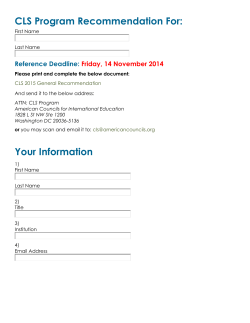
CLS and Heart Failure
Cardiac Rhythm Management // CLS and Heart Failure CLS and Heart Failure Therapy folder CLS and Heart Failure Therapy folder 387 487/A /1307 1 Jorde UP et al.; European Journal of Heart Failure; 10 (2008) 96–101. 2Garcia LI et al.; Chronotropic incompetence is an independent predictor of mortality in patients with advanced CHF; J Am Coll Cardiol 2009; 53: A194. 3Peter H. Brubaker, et al., Chronotropic Incompetence - Causes, Consequences, and Management, Circulation. 2011; 123: 1010–1020. 4Tse HF et al.; The incremental benefit of rate-adaptive pacing on exercise performance during cardiac resynchronization therapy; J Am Coll Cardiol 2005; 46: 2292–7. Maass AH. Importance of heart rate during exercise for response to cardiac resynchronization therapy. J Cardiovasc Electrophysiol 2009; 5 20: 773-80 6Sims D. B. et al.; Rate responsive pacing using cardiac resynchronisation therapy in patients with chronotropic incompetence and chronic heart failure. Europace 2011 7Beliaev O.V. et al.; Heart Rate Variability over 24 Hours – Closed Loop Stimulation and Motion-Sensor Pacemakers Compared with Healthy Control Group; Prog. Biomedical Res. 1999; Vol. 4; 146–148 8Wojciechowski D et al.; Clinical Results of Contractility-Based Closed Loop Stimulation in Patients Treated with Beta-Blockers; Prog Biomed Res 2001; Vol 6: 303–307. 0123 0681 © BIOTRONIK SE & Co. KG All rights reserved. Specifications are subject to modification, revision and improvement. BIOTRONIK SE & Co. KG Woermannkehre 1 12359 Berlin · Germany Tel +49 (0) 30 68905-0 Fax +49 (0) 30 6852804 sales@biotronik.com www.biotronik.com 70% of CHF patients have chronotropic incompetence (CI) CI occurs in over 70 % of advanced systolic CHF patients irrespective of beta-blocker use1 CI is an independent predictor of mortality.2 Physiological rate with CLS Appropriate rate is the key 20 % increase in VO2 max can be achieved using an No CI 30% CI 70% HF patients need an appropriate increase in HR to compensate appropriate rate adaptive pacing in HF patients with severe CI (< 70% HR)6 for their inadequate stroke volume during physical exertion.3,4 Oxygen consumption in CI patients Cumulative incidence of death in HF patients 40 CI present CI absent 35 Peak oxygen consumption (ml/kg/min) CI increases the risk of death 22 DDD CRT-pacing DDDR CRT-pacing p < 0.05 20 18 16 Peak oxygen consumption during DDD and DDDR modes in patients who achieved 70% (n 11), and 70% to 85% (n 9) of age-predicted HR during exercise using DDD-OFF mode 14 12 10 0 < 70% 30 70–85% 25 20 15 CLS makes the difference 10 5 CLS is not based on movement of the patient, which 0 0 CIPre 113 CIAbs 57 5 10 15 20 65 49 65 45 38 37 26 32 25 might be very limited in patients with severe CHF.1 months CLS is the only rate-adapting algorithm reacting both on physical and mental stress. CI is associated with CRT non-response CLS is not influenced by the patients’ drug therapy.7 CI is a predictor for non-response to CRT in patients in sinus rhythm.5 Heart Rate in β-blocked patients NN responders Total CI 36% Responders At 6 months of follow-up, responders significantly less frequently were chronotropic incompetent: responders 10% versus non-responders 36 % 10% 0 10 20 30 40 50 60 (%) Heart rate (beats/min) Chronotropic Incompetence in non-responders HF patients 140 Beta-blocker No Beta-blocker 120 100 80 60 No significant difference between patients with/without β-blocker use, during different kinds of physical activities.8 40 20 0 Day Night Rest Walk Stairs down Stairs up
© Copyright 2025



















